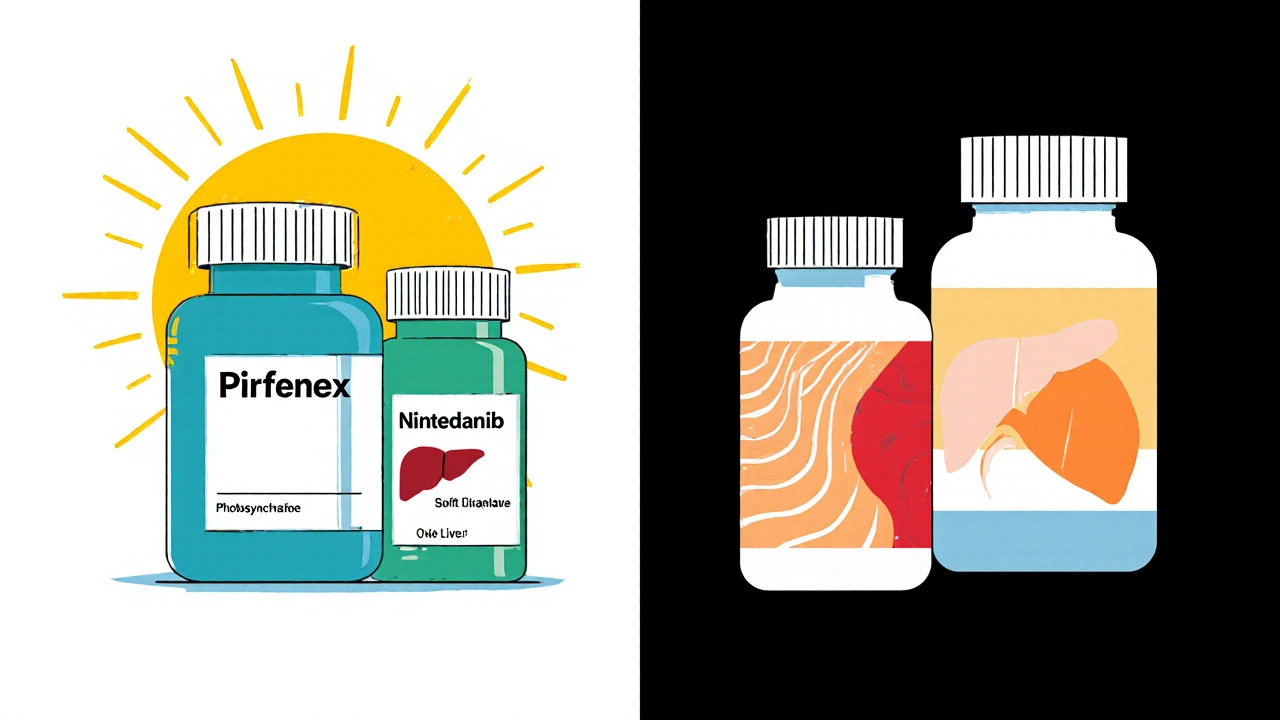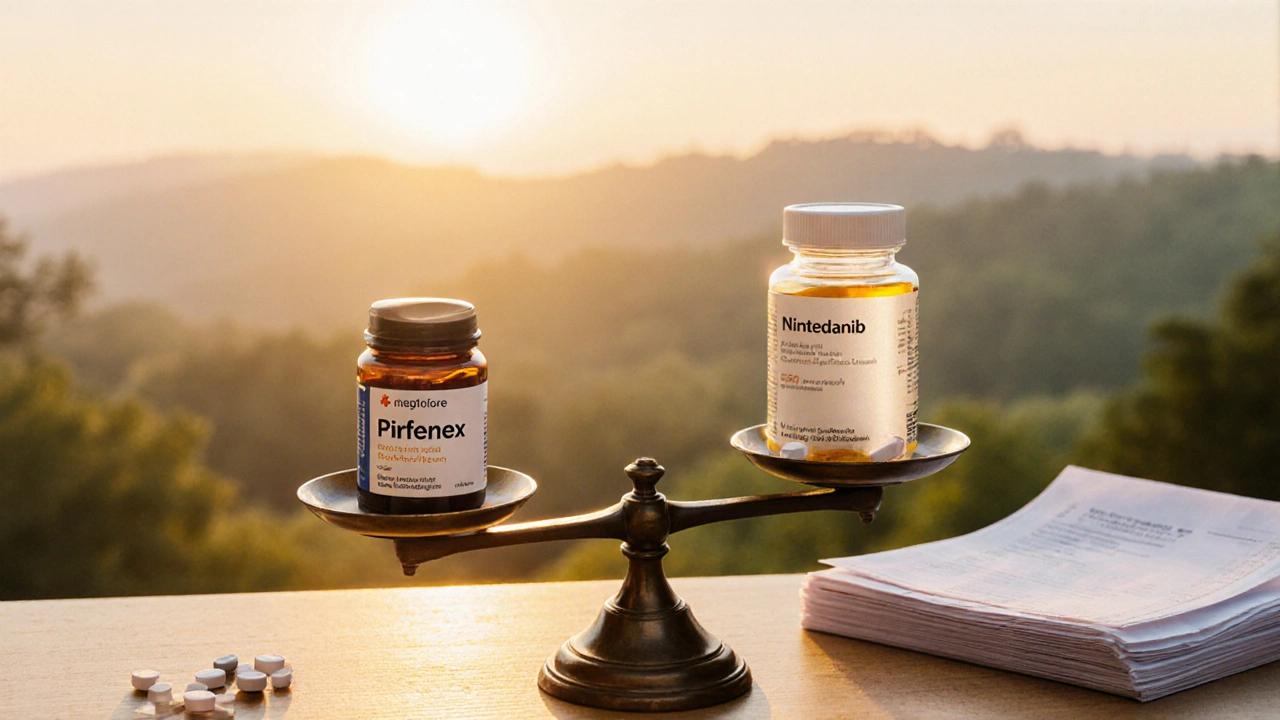Pirfenex vs. Nintedanib Comparison Tool
Drug Class: Pyridone derivative
Approval Year: 2014
Primary Mechanism: Reduces TGF-β and TNF-α pathways
Side Effects: Nausea Rash Photosensitivity Liver enzymes
Drug Class: Tyrosine kinase inhibitor
Approval Year: 2014
Primary Mechanism: Inhibits receptor tyrosine kinases
Side Effects: Diarrhea Nausea GI upset
Treatment Recommendation
Important: This tool provides general guidance only. Consult your healthcare provider for personalized medical advice.
Key Takeaways
- Pirfenex and nintedanib are the only two FDA‑approved antifibrotic drugs for idiopathic pulmonary fibrosis (IPF).
- Both slow forced vital capacity (FVC) decline by roughly 45‑50%, but their side‑effect profiles differ markedly.
- Pirfenex requires dose titration and is associated with liver‑related labs, while nintedanib often causes diarrhea and nausea.
- Cost is a major decision factor: public insurance coverage varies, and out‑of‑pocket expense can exceed $10,000 per year for each drug.
- Choosing the right therapy hinges on individual tolerance, comorbidities, and lifestyle preferences.
When faced with idiopathic pulmonary fibrosis, patients often wonder whether Pirfenex (pirfenidone) truly offers the best chance to slow the disease. This article pulls apart the data, side‑effects, dosing quirks, and price tags of Pirfenex and its main competitor, nintedanib, plus a quick look at emerging alternatives. By the end you’ll know exactly which drug aligns with your health profile and daily routine.
What Is Pirfenex?
Pirfenex is the brand name for pirfenidone, an oral antifibrotic approved by the FDA in 2014 for treating IPF. It belongs to the class of pyridone derivatives and works by dampening fibroblast activation and reducing the production of cytokines that drive scar tissue in the lungs.
How Pirfenex Works - The Science in Simple Terms
Instead of attacking the disease directly, pirfenidone modulates pathways that lead to collagen buildup. Think of it as turning down the volume on a radio that’s been blaring too loud for too long. By lowering transforming growth factor‑beta (TGF‑β) and tumor necrosis factor‑alpha (TNF‑α), the drug helps keep lung tissue more flexible.
Clinical Efficacy: What the Trials Show
The pivotal CAPACITY and ASCEND studies enrolled over 1,200 patients worldwide. In the pooled analysis, Pirfenex reduced the annual decline in FVC by about 47% compared with placebo. Mortality at 12 months was also lower (8% vs. 12%). These results have been replicated in real‑world registries, where the average yearly FVC loss drops from 200ml to roughly 100ml after starting the drug.

Dosage, Titration, and Safety Profile
Pirfenex is taken three times daily with meals. The regimen starts at 267mg each dose and ramps up over two weeks to a maintenance dose of 801mg three times daily (total 2,403mg). This slow titration helps mitigate gastrointestinal upset.
Common side‑effects (≥10% of users) include:
- Nausea and dyspepsia
- Rash and photosensitivity - patients should use sunscreen
- Elevated liver enzymes - monthly liver‑function tests are recommended
Serious hepatotoxicity is rare (<1%) but warrants immediate discontinuation if ALT/AST rise beyond three times the upper limit of normal.
Alternative Antifibrotics: The Main Contenders
Nintedanib, sold as Ofev, is the only other FDA‑approved oral antifibrotic for IPF. It belongs to the tyrosine‑kinase inhibitor class and blocks receptors involved in fibroblast proliferation.
Other agents-such as pamrevlumab (an anti‑CTGF antibody) and PRM‑151 (pentraxin‑2) - remain in phaseIII trials and are not yet widely available. For the purpose of this comparison we focus on nintedanib, the only FDA‑approved alternative.
Side‑Effect Spectrum of Nintedanib
Nintedanib’s most frequent adverse events are gastrointestinal:
- Diarrhea (up to 60% of patients)
- Nausea and abdominal pain
Liver enzyme elevations occur in about 5% of users, usually mild. Unlike Pirfenex, photosensitivity is not a concern, but patients should be aware of a slight increase in bleeding risk, especially if they take anticoagulants.
Cost and Access Considerations
Pricing varies by insurance and geography. In the United States, the average wholesale price (AWP) for a 30‑day supply is:
- Pirfenex: ≈$12,500
- Nintedanib: ≈$11,800
Both drugs qualify for the Medicare PartD “coverage gap” exception for high‑cost specialty drugs, but patients on private plans often face a 20‑30% co‑pay. Assistance programs from the manufacturers can shave up to $5,000 off the annual bill for qualifying patients.
Side‑by‑Side Comparison Table
| Attribute | Pirfenex (pirfenidone) | Nintedanib (Ofev) |
|---|---|---|
| Drug class | Pyridone derivative (antifibrotic) | Tyrosine‑kinase inhibitor |
| Mechanism | Reduces TGF‑β & TNF‑α, modulates fibroblast activity | Blocks PDGF, VEGF, FGF receptors |
| FDA‑approved indication | Idiopathic Pulmonary Fibrosis | Idiopathic Pulmonary Fibrosis |
| Typical FVC preservation (12mo) | ~47% reduction in decline | ~49% reduction in decline |
| Common side‑effects | Nausea, rash/photosensitivity, liver enzyme rise | Diarrhea, nausea, mild liver enzyme rise |
| Dosing schedule | 801mg TID after titration | 150mg BID with food |
| Annual cost (US AWP) | ≈$12,500 | ≈$11,800 |
| Special monitoring | Liver function every 4‑6weeks | Liver function every 3‑6months, watch for bleeding |

Decision‑Making Criteria
When picking between the two, consider the following factors:
- Gastrointestinal tolerance: If diarrhea is a deal‑breaker, Pirfenex may feel gentler.
- Liver health: Patients with pre‑existing hepatic disease should be closely monitored on Pirfenex, while nintedanib’s liver impact is milder.
- Photosensitivity concerns: Outdoor workers or those on photosensitizing medications might lean toward nintedanib.
- Pill burden: Pirfenex’s three‑times‑daily schedule can be inconvenient compared with nintedanib’s twice‑daily dosing.
- Insurance coverage: Check formulary status; some plans place nintedanib on a preferred tier, lowering co‑pay.
Best‑Fit Scenarios
Pirfenex is ideal for: patients who can manage multiple daily doses, have no severe liver disease, and prefer to avoid frequent diarrhea.
Nintedanib shines for: individuals who struggle with nausea or rash, have stable liver labs, and value a simpler twice‑daily regimen.
Emerging agents may become options for those intolerant to both, but currently they remain investigational.
Practical Tips for Managing Side Effects
- Take Pirfenex with a full meal; small, frequent snacks reduce nausea.
- Use a broad‑spectrum sunscreen (SPF30+) daily if on Pirfenex.
- For nintedanib‑induced diarrhea, start loperamide at the first sign and stay hydrated.
- Schedule liver‑function tests before initiation, then every 4-6weeks for the first three months.
- Maintain a symptom diary; share trends with your pulmonologist at each visit.
Frequently Asked Questions
Can I switch from Pirfenex to nintedanib if I can’t tolerate side effects?
Yes. A wash‑out period of about two weeks is recommended to let pirfenidone clear the system before starting nintedanib. Always coordinate the switch with your pulmonologist to monitor lung function and liver enzymes during the transition.
Do both drugs improve survival, or only slow disease progression?
Both have shown modest survival benefits in long‑term extensions of the CAPACITY, ASCEND, and INPULSIS trials. The primary regulatory endpoint is slowing the decline in forced vital capacity, but reduced mortality has been observed, especially when treatment begins early.
Is it safe to take either drug while on anticoagulants?
Nintedanib carries a slight increased bleeding risk because it inhibits platelet‑derived growth factor pathways. If you’re on warfarin, DOACs, or aspirin, your doctor may prefer Pirfenex or adjust anticoagulant dosing. Close lab monitoring is essential.
How do I know if my liver tests are concerning?
An ALT or AST level that climbs to three times the upper limit of normal (ULN) should trigger a repeat test within 48‑72hours. If it stays elevated or rises further, discontinuation of Pirfenex is advised. Nintedanib’s thresholds are similar but usually less frequent.
Are there any lifestyle changes that boost the effectiveness of these drugs?
Smoking cessation, pulmonary rehabilitation, and regular aerobic activity improve overall lung capacity and can amplify the modest benefits of antifibrotics. Vaccinations against influenza and pneumococcus also reduce infection‑related exacerbations.
Next Steps for Patients and Clinicians
If you’re newly diagnosed, schedule a baseline pulmonary function test and liver profile before starting any therapy. Discuss insurance formulary placement with your pharmacist to understand out‑of‑pocket costs. Consider a trial period of each medication (if covered) to gauge tolerance; many physicians allow a short switch if side effects dominate.
Remember, the goal isn’t cure-there’s none yet-but buying time with a better quality of life. Talk openly with your care team, track symptoms, and revisit the treatment plan every 6‑12months.
In short, Pirfenex offers a solid efficacy record with a side‑effect suite that leans toward liver and skin, while nintedanib trades those for more frequent gastrointestinal upset. Your personal health backdrop and budget will tip the scales.


Tesia Hardy
October 9, 2025 AT 22:46Hey folks, just wanted to say that the titration schedule for Pirfenex can feel like a marathon, but it really helps dial down the nausea. Start low, go slow, and keep a food diary – it makes the GI side‑effects way more manageable. Also, keep an eye on those liver labs every month, especially if you’ve got any mild impairment. If you’re juggling other meds, talk to your pharmacist about possible interactions. Remember, consistency is key; missing doses can drop the benefits fast. Stay positive and keep pushing through the first few weeks – the lungs will thank you later!
Matt Quirie
October 12, 2025 AT 06:33Regarding the comparative efficacy, both Pirfenex and Nintedanib demonstrate roughly a 45‑50% reduction in FVC decline, which, when expressed in absolute terms, translates to an approximate 100 ml preservation per year compared to placebo; this figure is statistically significant, and the confidence intervals overlap substantially, indicating comparable therapeutic benefit.
Pat Davis
October 14, 2025 AT 15:30The data from CAPACITY and ASCEND clearly show that Pirfenex achieves a 47% slowdown in FVC loss, and when you juxtapose that against the 45% figure for Nintedanib, the marginal difference is clinically negligible; however, the side‑effect profile-especially the hepatic considerations-should tip the decision in patients with pre‑existing liver concerns.
Mary Wrobel
October 16, 2025 AT 23:53Look, if you’re the type who hates running to the bathroom after every pill, Nintedanib’s diarrhea can feel like an endless marathon, whereas Pirfenex’s rash and photosensitivity are more like a rainy‑day inconvenience – just slather on SPF and you’re good to go.
Lauren Ulm
October 19, 2025 AT 08:00The pharma giants are hiding the real cure behind layers of patents and profit motives 😒
Michael Mendelson
October 21, 2025 AT 16:06Honestly, most patients are just chasing a shiny label; both drugs cost the same, neither is a magic bullet, and the side‑effects are just another way the industry keeps us in a chronic loop of dependence.
Ibrahim Lawan
October 24, 2025 AT 00:30From a therapeutic philosophy standpoint, the choice between Pirfenex and Nintedanib can be seen as a balance between hepatic stewardship and gastrointestinal tolerance. The key is aligning the drug’s mechanistic focus with the patient’s comorbid landscape. If liver enzymes are already flirting with the upper limit of normal, Pirfenex might introduce unnecessary risk. Conversely, a history of chronic diarrhea would make Nintedanib a less appealing option. Insurance coverage often levels the playing field on cost, so clinical nuance becomes the decisive factor.
Just Sarah
October 26, 2025 AT 08:53It is imperative, therefore, to conduct a thorough assessment of hepatic function, gastrointestinal tolerance, and insurance parameters prior to initiating therapy; this ensures optimal alignment of pharmacologic profile with patient-specific variables.
Anthony Cannon
October 28, 2025 AT 17:00Either drug works, pick based on side‑effects.
Kristie Barnes
October 31, 2025 AT 01:23Honestly, I’m kinda shy about sharing my experience, but the dose‑escalation for Pirfenex was a real pain. I missed a couple of weeks and felt my breath get worse. If you can stick to the schedule, it’s worth it.
Zen Avendaño
November 2, 2025 AT 09:46Stop beating around the bush – if you can tolerate a bit of rash, Pirfenex wins because the liver monitoring is less aggressive than Nintedanib’s GI fallout.
Michelle Guatato
November 4, 2025 AT 18:10They don’t tell you that these drugs are just a test for the next big profit push. The data is filtered, the side‑effects are downplayed, and the real cure is hidden behind a wall of regulatory jargon.
Gabrielle Vézina
November 7, 2025 AT 02:33Pirfenex causes rash and photosensitivity while Nintedanib leads to diarrhea – choose the lesser of two evils based on personal tolerance
carl wadsworth
November 9, 2025 AT 10:56Let’s keep the conversation grounded: both drugs have similar efficacy, so the decision should hinge on side‑effect profile, liver vs GI considerations, and what your insurance actually covers.
Tesia Hardy
November 11, 2025 AT 19:20I hear you, Gabrielle, and while the grammar‑centric view is interesting, the real takeaway for patients is the practical side‑effects: a rash is often easier to manage than constant bathroom trips. So, weigh what you can live with day‑to‑day.
Ibrahim Lawan
November 14, 2025 AT 03:43When we examine the broader pharmacoeconomic landscape, the parity in annual cost between Pirfenex and Nintedanib eliminates price as a primary discriminant for most insured patients. Yet, beyond the headline numbers, the hidden costs associated with monitoring and managing adverse events must be accounted for. Monthly liver function tests for Pirfenex translate into additional lab fees and clinic visits, which can cumulatively burden patients with limited access to care. Conversely, the gastrointestinal side‑effects of Nintedanib often necessitate anti‑diarrheal agents, dietary adjustments, and occasionally dose reductions, each carrying its own expense and quality‑of‑life impact. In clinical practice, the decision matrix is further refined by comorbid conditions; for instance, a patient with pre‑existing hepatic steatosis may be steered toward Nintedanib to avoid exacerbating liver enzyme elevations. Similarly, an individual with irritable bowel syndrome might find Pirfenex more tolerable despite the need for vigilant dermatologic protection against photosensitivity. The therapeutic inertia observed in some treatment pathways often stems from physician familiarity rather than robust comparative data, underscoring the need for multidisciplinary discussions. Real‑world registries have shown that adherence rates dip when side‑effects are not proactively managed, leading to suboptimal disease control and higher hospitalization rates. Moreover, the psychosocial dimension cannot be ignored; patients frequently report anxiety over potential liver damage, which can affect medication adherence more than the physical side‑effects themselves. Insurance formularies sometimes preferentially list one agent over the other, prompting formulary switches that disrupt continuity of care. It is therefore essential for clinicians to engage patients in shared decision‑making, outlining both the statistical efficacy and the lived experience of each therapy. By aligning treatment choice with patient values, lifestyle, and comorbidity profile, we can maximize both clinical outcomes and patient satisfaction. In summary, while the efficacy gap between Pirfenex and Nintedanib is negligible, the nuanced differences in side‑effect management, monitoring burden, and individual patient circumstances should guide personalized therapy selection.